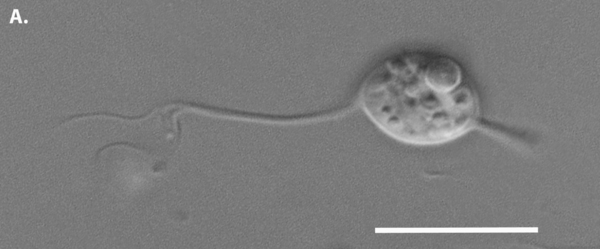Cthylla microfasciculumque: Difference between revisions
No edit summary |
|||
| (4 intermediate revisions by one other user not shown) | |||
| Line 1: | Line 1: | ||
[[Category:Short pages]] | |||
{{Uncurated}} | {{Uncurated}} | ||
[[Image:Cthylla.png|600px|thumb|right|''C. microfasciculumque'' displaying its flagella.]] | |||
==Classification== | ==Classification== | ||
Eukaryota; Excavata; Metamonada; Parabasalia; Parabasalia incertae sedis | ===Higher order taxa=== | ||
Eukaryota; Excavata; Metamonada; [[Parabasalia]]; Parabasalia incertae sedis | |||
===Species=== | ===Species=== | ||
| Line 25: | Line 31: | ||
==Author== | ==Author== | ||
Page authored by Graden Barnes and Michael Paxhia, | Page authored by Graden Barnes and Michael Paxhia, students of Professors Edward Walker and Kazem Kashefi at Michigan State University. | ||
<-- Do not remove this line-->[[Category:Pages edited by students of Jay Lennon at Michigan State University]] | <!-- Do not remove this line-->[[Category:Pages edited by students of Jay Lennon at Michigan State University]] | ||
Latest revision as of 14:40, 28 September 2015
Classification
Higher order taxa
Eukaryota; Excavata; Metamonada; Parabasalia; Parabasalia incertae sedis
Species
Cthylla microfasciculumque
Description and Significance
Cthylla microfasciculumque is a small flagellate found in the hindgut of lower termites; specifically Reticulitermes virginicus. This symbiont bears a similar appearance to Cthulhu macrofasciculumque with a single anterior nucleus and five anterior flagellum that the organism beats in a highly recurrent pattern for mobility. C. microfasciculumque is a Parabasalia, the microbes responsible for the breakdown of cellulose for use by the host termite. The study of C. microfasciculumque may lead to further insights as to how larger Parabasalia evolved.
Genome Structure
Cthylla microfasciculumque was classified by using a 1500bp sequence of SSU rRNA, but as of April 2013 the genome has not be sequenced. The microorganism is most similar to members of the family Hexamastigidae.
Cell Structure, Metabolism and Life Cycle
Named after the secret daughter of H.P. Lovecraft's iconic monster Cthulhu, Cthylla microfasciculumque possesses five anterior flagellum used for mobility, reminding scientists of Lovecraft's octopus headed monster. The cell also possesses a single anterior nucleus associated with an axostyle projecting from the posterior end of the cell. C. microfasciculumque was isolated alongside other Parabasalia and most likely metabolizes cellulose for use by the host termite, but its exact metabolism has not yet been studied.
Ecology and Pathogenesis
Cthylla microfasciculumque was isolated from the hindgut of the termite Reticulitermes virginicus. The microorganism lives in a symbiotic relationship with its host as a member of the microbial community responsible for the breakdown of lignocellulose. C. microfasciculumque was found alongside larger and better described members of R. virginicus hindgut including: Trichonympha, Spirotrichonympha, Dinenympha, and Pyrsonympha.
References
Author
Page authored by Graden Barnes and Michael Paxhia, students of Professors Edward Walker and Kazem Kashefi at Michigan State University.

